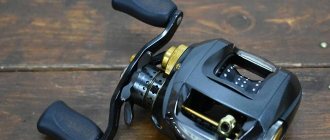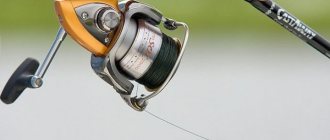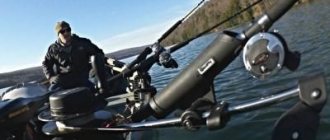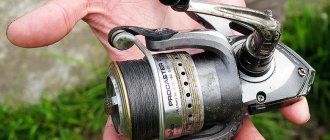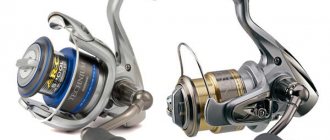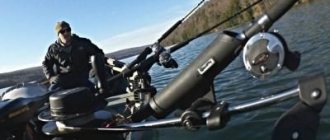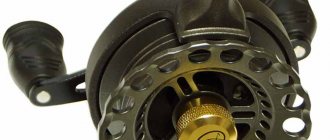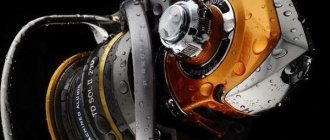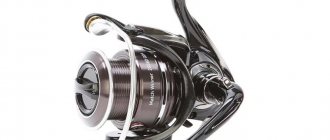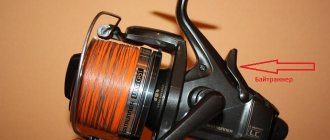A multiplier reel is one of the types of fishing reels, an improved prototype of inertial reels used in spinning fishing.
Trolling, jigging or simply catching a trophy predator from the shore will not be possible without this fishing equipment. A reel with the unusual name “multiplying” appeared as a result of a love for fishing and has become an integral and in demand among millions of anglers around the world.
The unusual history of the appearance of the reel, its design features, nature of application, differences from the inertialess reel, secrets of care - you will learn from this review.
Content
- 1. The history of the appearance of the first multiplier reel
- 2. Advantages and disadvantages of the multiplier
- 3. Differences between a multiplier reel and a spinning reel
- 4 Types of baitcasting reels
- 5. How a baitcasting reel works and works
- 5.1 Braking system in the multiplier reel
- 5.2 Location of multiplier handles
- 5.3 Coil power
- 5.4 Features of the line guide
The history of the first multiplier reel
The English name of the multiplier sounds like multiplier, multiplier reel and is literally translated as “multiplying reel”, since in one turn the spool can turn up to 6 rapid revolutions. It is interesting that the mechanism of action of this “multiplying” reel is very similar to that of a watch reel, and some sources indicate that it was watch workshops that first started manufacturing this type of fishing reel...

So, if we go back to 1821 (Kentucky), we will see that this year is significant in that it was then that the “multiplying coil” was first invented by a skilled watchmaker, an excellent jeweler and an avid fisherman, George Snyder. He created this know-how exclusively for his own use, but the reel became so popular that he started producing it for members of his fishing club, where he held the presidency.
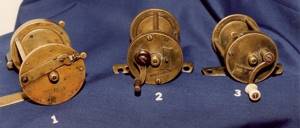
Read more about the evolutionary appearance of the “Kentucky” reels in the original at https://library.la84.org/SportsLibrary/Outing/Volume_37/outXXXVII03/outXXXVII03g.pdf
Advantages and disadvantages of the multiplier
Advantages of an animator:
- You can use heavy weight baits;
- the fishing line does not twist;
- the center of gravity is concentrated on the form (in the area where the hand works), which is convenient when manipulating the tackle;
- casting accuracy;
- ability to control casting;
- small dimensions;
- powerful traction;
- the ability to make long casts;
- lack of windage during wiring in windy weather;
- the ability to improve the qualities of the animator through tuning;
- high sensitivity to bites.
Disadvantages of a baitcasting reel:
- high cost;
- a special spinning rod (casting) with upper or spiral placement of rings is required;
- constant adjustment of the brake system;
- systematic maintenance;
- careful operation;
- not suitable for fishing in winter;
- discomfort when holding the coil.
Read more about this type of spinning rod as casting and its features here
Spinning reel or multiplier
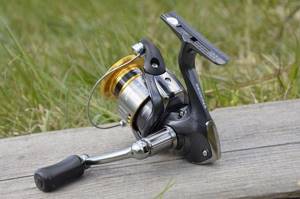
Today this question faces many fishermen and does not contain a clear answer. Each of these types of coils has its own advantages. For inertialess gear they are:
- ease of casting, skill acquired very quickly;
- the line rarely forms a “beard” even when casting long distances
- light weight;
- fast rewinding, with one turn of the handle you can reel in up to 1 m of fishing line;
- friction brake sensitivity.
The multiplier reel has its advantages:
- casting with its help is also easy;
- such a reel is good when using heavy bait;
- allows the use of thick fishing line;
- Fishing this way is less energy intensive.
Differences between a multiplier reel and a spinning reel
The pros and cons of a baitcasting reel, as well as its difference from a spinning reel, can be seen in a short video from INFISHING tv
If, for example, fishing is aimed at catching a trophy specimen, then the multiplier is your reliable friend, but if you are aiming to hunt small inhabitants, then you will have disagreements with the multiplier due to inconvenience in handling, since it is intended for large and characteristic prey.
The battle in matters of the braking system is won by a spinning reel, since in cartoons you constantly have to adjust the brake for a specific bait and type of prey.
If a multiplier reel is lighter than a spinning reel, then the latter is easy to use and suitable for beginners, but with a multiplier you will have to learn.
The handle of the reel in the inertia-free reel can be adjusted to suit your hand; when using a multiplier, there is an inconvenience that boils down to shifting from hand to hand, especially right-handed people will feel this, and it’s difficult to handle the reel attached to the top of the form without getting used to it.
One of the main differences between a multiplier is that it is suitable only for a certain type of spinning rod, while a spinning rod is a universal mechanism.
In any case, each spinning player chooses tackle and reel only for himself, his skill and type of fishing.
Types of baitcasting reels
Types of fishing bait reels:
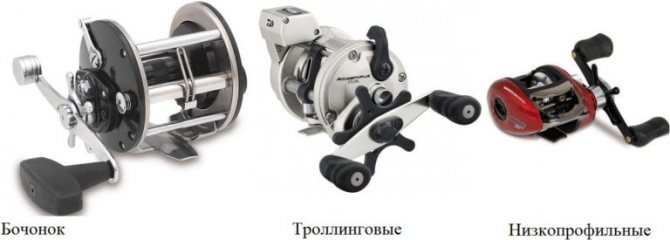
A round-shaped reel or, as spinning anglers call it, a “barrel” should be used when fishing with heavy baits weighing 15-70 g and require the use of powerful fishing threads.
Trolling reels have a line counter (for setting the desired depth of the bait) and are the most powerful type of multiplier reels designed for powerful loads.
The third type of “soap box” or low-profile reels are suitable for casting light-weight lures.
A detailed article about the types and features of baitcasting reels may interest you https://kaliningradfishing.ru/zhur-sr/2008-04/statja-003.html
Top 5 Budget Trolling Reels
• Kosadaka Troll 800L
: left hand trolling reel. Designed for catching large fish. Powerful and functional. Weight is 744 g, forest capacity is 0.50 mm/250 m, speed ratio is 6.2:1.
• Shakespeare Omni Multiplier 20LB LH
: Left hand multiplier reel. It has a durable graphite body, the internal mechanism is equipped with an enlarged gear, which allows you to work with heavy baits. Weight - 506 g, spool capacity - 0.25 mm/300 m, speed ratio - 3.8:1.
• Salmo Diamond TROLL 2 M6400
: A baitcasting reel for trolling or casting that can withstand heavy loads. Two ball bearings are made of steel. The STAR DRAG clutch is easy to adjust and ensures stable operation. Weight – 464 g, forest capacity – 0.25 mm/150 m, speed ratio – 4.2:1.
• Surf Master Magnum MAG
: Right-handed power multiplier reel made of composite material. The spool is metal with increased line capacity. Weight is 700 g, forest capacity is 0.50 mm/375 m, speed ratio is 4.4:1.
• Trolling Master TMR
: A reliable reel used for river and lake trolling. Equipped with a line counter and multi-disc braking system. The spool is made of aluminum. Weight – 523 g, spool capacity – 0.45 mm/200 m, speed ratio – 3.8:1.
How does a baitcasting reel work and how does it work?
Compared to a spinning reel, the multiplier is simpler in design, but there are some special features.
The fishing line is laid using a worm gear. The load is transferred to the spool drum, which has a cylindrical shape thanks to a gear transmission with a drive mechanism.
Casting is carried out through various types of mechanisms (braking system, centrifugal and magnetic), which are adjustable and reduce tangling of the fishing line.
5.1 Braking system in the multiplier reel
About the brake system, its types and selection rules, see the general review of multipliers from the Shcherbakov brothers
5.2 Location of multiplier handles
Mules with a right-handed handle are suitable for those spinning players who have experience using inertial reels, that is, after casting with your right hand, you need to transfer the form to your left hand and start retrieving. Why is the placement of the handle so important? It's simple. It is at the moment of changing hands that the long-awaited bite can occur and a second of confusion will ruin everything.
For fans of inertia-free fishing, you can opt for the left-hand placement of the handle, since after casting with your right hand, the fishing line will be reeled in with your left hand and there is no need to shift the tackle.
Tip: when purchasing a multiplier fishing reel, test both handles in the store.
5.3 Coil power
If you pay attention to the inscriptions made on the body of the fishing reel, you can see information about the permissible load and the diameter of the fishing line. For example, if you use a thin braid, smaller in diameter than provided by the manufacturer, then it will definitely get stuck.
The minimum permissible diameter and maximum load indicate that if you use more powerful tackle, the reel with such parameters may not withstand it. Also, the power of the reel is determined by the number of revolutions of the reel drum per revolution of the handle (gear ratio) and the lower this number, the more powerful the reel and the lower the speed of reeling in the line. Powerful reels are those whose gear ratio does not exceed 4.8 revolutions.
5.4 Features of the line guide
A special feature of the multiplier line layer is the winding of the fishing line in a helical manner. If, while winding the fishing line, you observe how the layer runs from cheek to cheek, this indicates the quality of the winding. In this process, the speed of the reel drum depends on the line handler runner. However, with this method of reeling, the fishing line loses up to 10% in range when casting it. To save interest, you need to remove the line guide and adjust the placement of the thread with your fingers. Therefore, to simplify this process, when purchasing, you should choose a multiplier reel that has a function to turn off the line guide. In this case, it is worth knowing the following. Before casting, the line guide is positioned in the center of the drum. Failure to maintain alignment will result in the line becoming tangled. Reels with no shut-off function should be used when fishing with heavy jigs or jerking.
Read about what jerking is and what baits are used for this fishing technique here
For fishing with bait weighing no more than 25 g, the first version of the cartoon is suitable.
The line guide can have either a wire fork or a ceramic eye.
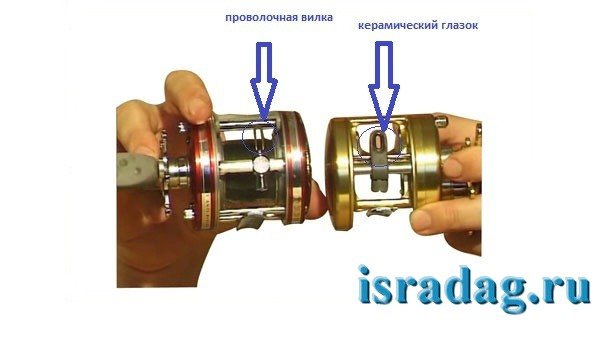
When and which element of the line laying machine is important:
- for monofilament fishing line, you can use both;
- for wicker - a line guide with a ceramic eye.
It is worth knowing that a wire fork wears out over time, which can damage fishing threads.
Advice: since the braid has a smooth (sliding) structure, to avoid its rotation on the spool, you need to make a winding, for example, from a patch (electrical tape), winding it as the first layer.
Features of choosing multiplier reels
Content
Multipliers are lightweight and small in size. The smallest of them weighs 160 g, having a pulling force of 4 kg. Reels are divided into classes: heavy, light, troll.
Key points to consider when choosing a reel:
- Between a metal and plastic case, you should choose the first option. This helps to increase the service life and protect against mechanical stress;
- The mechanical brake must be in good working order. Reels with magnetic braking and centrifugal brake are considered the best;
- Left-handed and right-handed products are available for sale. Decide in advance which option will be convenient for you;
- choosing a reel for a specific fishing line. The recommended line diameter is indicated on each product;
- A good reel should not only have a modern design. Note the smooth ride and additional features.

The multiplier reel is a modern continuation of the development of the once popular inertia reel
Casting technique with a multiplier reel
V. Stebelkov demonstrates the casting technique
How to avoid fishing line getting tangled:
- the swing of the rod should not be strong and sharp, so as not to accelerate the spool with the swing;
- casting is done smoothly;
- When unwinding the fishing line, you need to hold the spool with your finger;
- In order to make a long cast, you need to lower the bait from the tip of the rod to a distance of at least 40 cm, this will accelerate the weight and tighten the line.
